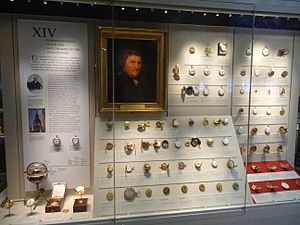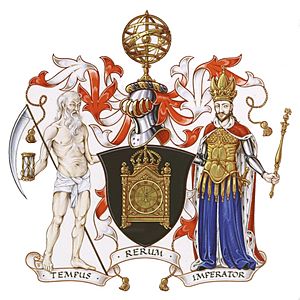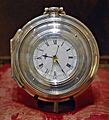Clockmakers' Museum facts for kids

A display of 19th century domestic watchmaking, at the Clockmakers' Museum
|
|
| Lua error in Module:Location_map at line 420: attempt to index field 'wikibase' (a nil value). | |
| Established | 1814 |
|---|---|
| Location | Science Museum, London |
| Accreditation | Arts Council England |
| Collections | Emphasis on horology in London, 17th century to date |
The Clockmakers' Museum in London, England, is home to an amazing collection of clocks and watches. Many people believe it's the oldest collection of its kind in the world! This special museum is managed by the Clockmakers’ Charity. This charity is connected to the Worshipful Company of Clockmakers, which started way back in 1631.
Since 2015, the museum has been located inside the Science Museum in South Kensington. Before that, it was at the Guildhall in the City of London, where it first opened to the public in 1874. The best part? It's completely free to visit!
The museum's collection began in 1814. Its main goal is to teach everyone about the history of clock and watchmaking, also known as horology. It especially focuses on the history of this craft in the City of London. The museum also wants to encourage young people to consider careers in horology. This craft was even added to a list of endangered crafts in 2019, meaning it needs more people to learn and practice it.
Contents
Discovering the Museum's History
How the Collection Started
The Clockmakers Company first began collecting books in 1814. This was managed by a special committee. A very important person in this early history was Benjamin Lewis Vulliamy. He was a key figure for many years.
At first, meetings were held at Vulliamy's own place. But in 1817, the Company bought a special bookcase to hold its growing collection. This bookcase was placed in a room where the Company held its meetings.
Around 1815, the collection grew to include not just books, but also actual clocks and watches. One of the first items they got was a part from an old clock mechanism. This piece is still on display today!
Moving to the Guildhall
After some important people involved with the museum passed away in the 1850s, the collection needed new support. Luckily, a new building for the Guildhall Library was built in the early 1870s. The Clockmakers’ Museum was invited to move there. It opened to the public at the Guildhall in 1873.
In 1891, a big supporter named Rev Harry Leonard Nelthropp helped the Company get one of its most important items: John Harrison’s fifth marine timekeeper, called H5. This was a very important clock for navigation at sea. In 1894, Nelthropp also gave his own huge collection of watches, clocks, and other related items to the museum.
Changes and Growth Over Time
Over the years, the museum's collection was rearranged and new guides were created. During the Second World War, the collection was carefully taken apart and stored in a safe place away from London. This kept the valuable items safe from harm.
The museum moved again to a new Guildhall Library building in 1976. New catalogues were made to list all the clocks, watches, and books in the collection.
From the 1970s onwards, the museum saw many improvements. The collection of items and historical documents grew even more. Important additions included the Hurle-Bath and Hurle-Bradley watch collections. They also bought some original papers written by the famous clockmaker John Harrison.
Thanks to a generous gift from a collector named Reginald Gowan Beloe, the museum had enough money for a big renovation. It reopened with a new, larger display at Guildhall Library in 2001.
Finding a New Home at the Science Museum
When the museum's lease at Guildhall ended, a new home was found at the Science Museum. This was a big deal! The collection was moved during 2014 and 2015. The new gallery was officially opened by the Princess Royal on October 22, 2015.
The new gallery at the Science Museum is more than twice the size of the old one. Before the move, about 13,000 people visited the museum each year. Now, because it's inside the Science Museum, which gets over 3 million visitors annually, many more people can discover the amazing world of clockmaking!
The Clockmakers Museum is located on the second floor of the Science Museum. It's near other cool galleries like the Mathematics Gallery and Science City: 1500–1800.
The Museum's Amazing Collection
The museum's collection includes special portraits of clockmakers. It also has about 660 English and European watches, 30 clocks, and 15 marine timekeepers. These items are arranged in order from oldest to newest.
You can start by seeing objects from the 15th and 16th centuries. Then, you move through time to the 17th century, when clock and watchmaking really started to grow in London. As you walk through the gallery, you'll see items from the 18th and 19th centuries.
At the end of the display, you'll find more recent objects. These include watches made by George Daniels, a famous modern watchmaker. There's also an explanation of wristwatches being made today.
To help people learn about horology, the museum has an information board. It highlights places where new students can learn this craft, like West Dean College and the Birmingham School of Jewellery.
Highlights of the Collection
The museum has many incredible items. Here are some of the most famous:
- A unique Star watch by David Ramsay.
- Clocks and watches made by Edward East.
- A beautiful table clock by Samuel Knibb.
- An astronomical table clock by Samuel Watson, which might have belonged to Isaac Newton!
- Clocks and watches by the famous Thomas Tompion.
- Watches and clocks by George Graham.
- A marine timekeeper by Henry Sully.
- Longcase clocks by James Harrison and John Harrison.
- A watch by John Jefferys, made for John Harrison.
- John Harrison’s H5 marine timekeeper, a very important invention.
- Chronometers (very accurate timekeepers) by John Arnold and Thomas Earnshaw.
- Watches by Abraham-Louis Breguet.
- The Smiths wristwatch worn by Sir Edmund Hillary when he reached the top of Mount Everest.
- Watches by George Daniels, including the amazing Space Traveller watch.
- Original portraits of many important clock and watchmakers.
In 2019, the museum added a large portrait to its collection. It shows a well-dressed gentleman holding a fancy watch from the 1670s. This watch looks very similar to another old astronomical watch already in the museum.
Museum Accreditation
The Clockmakers' Museum is officially recognized as an "Accredited" museum by Arts Council England. This means it meets high standards for how it cares for its collection and how it operates. The museum first received this status in 2007. After it closed for the move to the Science Museum, it reapplied and was granted full Accredited status again in 2018.
Images for kids




